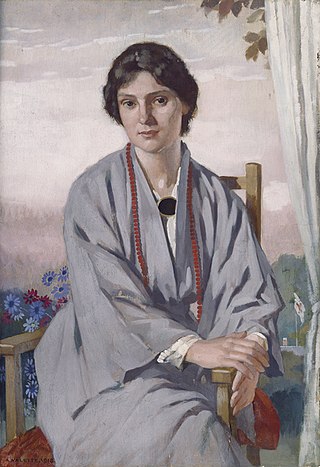Layla Rosalind Nashashibi is a Palestinian-English artist based in London. Nashashibi works mainly with 16 mm film but also makes paintings and prints. Her work often deals with everyday observations merged with mythological elements, considering the relationships and moments between community and extended family.

Sir Michael Craig-Martin is an Irish-born contemporary conceptual artist and painter. He is known for fostering and adopting the Young British Artists, many of whom he taught, and for his conceptual artwork, An Oak Tree. He is an Emeritus Professor of Fine Art at Goldsmiths. His memoir and advice for the aspiring artist, On Being An Artist, was published by London-based publisher Art / Books in April 2015.
Bernard Cohen is a British painter. He is regarded as one of the leading British abstract artists of his time.
Jane Simpson is a British artist who lives and works in Carmarthenshire. She primarily produces sculptures, using diverse elements such as ice, silicone rubber, wood, precious metals, glass, ceramics and household objects including items bought at flea markets and on eBay.
Laetitia Yhap is a British artist.

Kate Whiteford OBE is a Scottish artist. Her work includes painting, screen prints, textiles, land art and installations.
Claire Barclay is a Scottish artist. Her artistic practice uses a number of traditional media that include installation, sculpture and printmaking, but it also expands to encapsulate a diverse array of craft techniques. Central to her practice is a sustained exploration of materials and space.
Barry Martin is a British artist associated with the kinetic art movement of the 1960s, in which physical movement was incorporated into art. Martin has also explored ideas of movement in the activities of games: among artists whose work has explored chess, Martin has been described as "perhaps the most important". His work appears in the collections of the Victoria and Albert Museum, Tate, and British Council, among others. According to the Victoria and Albert Museum:
[Martin] has worked in various media - including kinetic sculpture, film, performance, and the making of environments - but the constant in his work has been drawing, either as a working tool, as a means of recording and observing, or as an end in itself. For Martin, drawing is a system of signs analogous to those of language, and also an intellectual process of enquiry, analysis and proposition.
Twyla Exner is a Canadian contemporary artist who resides in Prince George, British Columbia. She creates art works in various mediums, including drawing, sculpture, ceramics, and installation. Exner's pieces explore themes of nature, combined with technology and electronics, and have been exhibited across Canada. She is currently employed as the director of Public Programs at Two Rivers Gallery.

Percy Hague Jowett (1882–1955) was a British artist and arts administrator, principal of the Royal College of Art.
Agathe Sorel is a London-based artist of Hungarian descent, specializing in painting, sculpture, printmaking and livres d’artiste. She is a Member of the Royal Watercolour Society and the Royal Society of Painter-Printmakers, as well as a founding member of the Printmakers Council and was its Chairman in 1981-1983. She was one of the first artists who experimented with making objects and sculptures using print techniques.

May Aimée Smith (1886–1962) was an English painter and engraver.
Christopher John Eldon George Firmstone is a British graphic designer and visual artist. His work as a designer is known by a number of art galleries in London, where his commissions include designs for exhibition posters and the design of rooms for the display of artworks, most notably at the Victoria and Albert Museum. His own artworks have been exhibited in London and New South Wales, Australia, and a selection of his architectural photographs are held in the Courtauld Institute of Art Conway photographic library in London.
Terence Frederick Friedman (1940-2013) was an American-born art and architectural historian and museum curator. After his death in Leeds, UK, The Sculpture Journal, in their tribute, defined him as ‘a rare being - a scholar curator working in a regional museum, and an outstanding art historian, educator and collector’. He was also a highly acclaimed author and respected as a leading authority on 18th century ecclesiastical architecture. His book, The Eighteenth-Century Church in Britain, the first substantial study of the subject to appear in over half a century, won the William MB Berger Prize for British Art History in 2012.

Shelagh Wakely was a British sculptor and experimental artist.
Jacqui Poncelet, also known as Jacqueline Poncelet, is a Belgian artist. Poncelet began her art career as a ceramist in the 1970s and 1980s. In the 1980s her practice expanded to include painting, sculpture and public art.
Rachel Lowe is a British artist and filmmaker.
Jo Bruton is a British artist.

Permindar Kaur is a visual artist. She was included in the British Art Show in 1996. She is shortlisted for the Freelands Award 2022 for her upcoming exhibition at John Hansard Gallery.
Catherine Carman is an Irish sculptor, noted for large figurative works, often based on the human figure, in multiple materials. She is also a painter, and latterly additionally works with "found objects", digital imaging and sound. She is a member of Aosdána, Ireland's national academy of artists, and examples of her works are held in multiple major collections.





